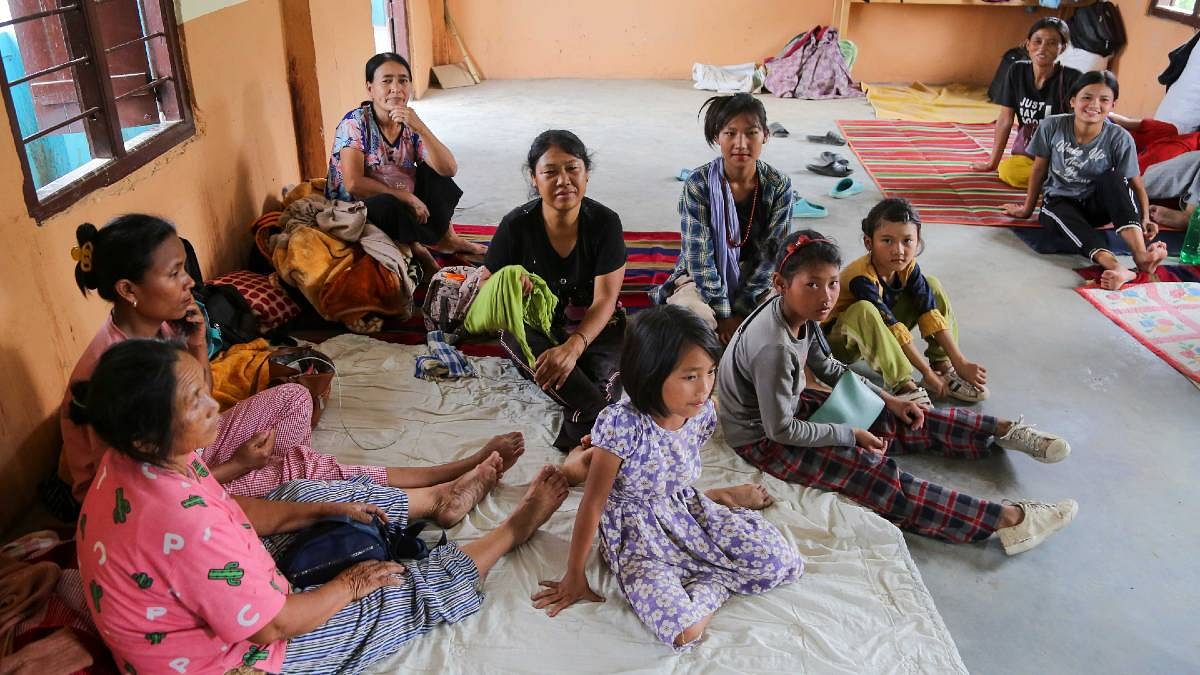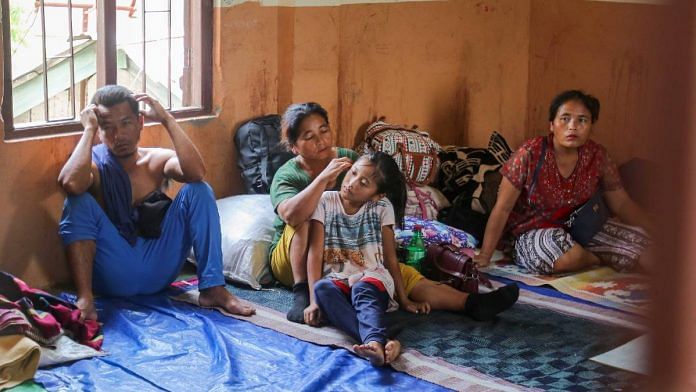Churachandpur (Manipur): At 2 am Sunday, the fear that Sugnu constituency residents have been living with ever since violence started between Manipur’s Meitei and Kuki communities earlier this month became a reality.
There were sounds of gunshots and word soon spread that the burning of houses had started in the constituency in Manipur’s Chandel district. As they fled to the nearby forest for shelter, many left home empty-handed, Kuki residents of Sugnu said when ThePrint caught up with them in relief camps in neighbouring Churachandpur district Monday.
“It was like a nightmare. We could hear gunshots and bullets were flying over our heads. We were terribly scared, but we had no other option. They [the Meiteis] were more in number and they have the government with them,” alleged Chinneihoi (who goes by a single name), a Kuki resident of Sokom village in Sugnu constituency. She — along with her four-year-old son and two-year-old daughter — was among those who sought safety in the forest that day.
Violence erupted between Manipur’s ethnic Kuki tribals and the non-tribal Meitei community earlier this month, centred on the Meiteis’ demand for Scheduled Tribe (ST) status, which the Kukis say is a bid to secure constitutional safeguards for the community.
Geographically, Manipur is divided into the hill and valley areas. The hill areas comprise 90 per cent of the state’s total geographical area and are predominantly inhabited by Naga and Kuki-Chin-Mizo or Zo ethnic tribes. The valley areas are dominated by non-tribals or Meiteis. Both Chandel and Churachandpur are in the hill areas of the state.
The 3 May ethnic clash in the state followed a solidarity march called by the All Tribal Students’ Union of Manipur to oppose the Meitei demand for ST status. The violence has reportedly so far claimed over 70 lives in the state, with the situation remaining tense since.
But Sugnu, in east Manipur, had managed to hold on to peace till the weekend. Kukis and Meiteis in the constituency had signed a peace agreement earlier this month, promising that they wouldn’t attack each other, residents told ThePrint.
That came to nought in the wee hours of Sunday, a day before Union Home Minister Amit Shah arrived in the state.
Kuki and Meitei residents of Sugnu ThePrint spoke to claimed the other side had attacked first, and Kuki and Zo tribals who escaped to neighbouring Churachandpur also claimed their trust in the administration and security forces was broken.
“We believed the Sugnu MLA, K. Ranjit Singh, who had assured us that no fight will happen here. But he fooled us. We cannot trust him anymore,” said Niengialam (who uses a single name). The 36-year-old escaped with her five children from V. Haipijang village in Sugnu.
Singh, a member of the Meitei community, is a Congress leader and the MLA for Sugnu. The constituency has a mixed population, comprising Meiteis and Kukis, as well as other communities like Nepalis and Bengalis.
The peace agreement was signed in front of Singh, claimed those ThePrint spoke to.

ThePrint reached MLA Singh over phone for comment, but received no response till the time of publication of this report. ThePrint also reached Kuldiep Singh, security advisor to Manipur CM Biren Singh, for comment, but received no response till the time of publication of this report.
M. Manihar Singh, a Meitei leader based in Imphal, however, told ThePrint that Meiteis were “peace-loving people. Since the beginning of this conflict, Kukis have been spreading lies that we are shooting at them. These are baseless. We never resorted to aggressive tactics. We committed no offensive actions. We are only reacting to save our property”.
Manihar Singh added: “Kukis have sophisticated weapons and they are resorting to cleansing mechanisms wherever Meiteis are intermingling with them.”
ThePrint had earlier reported how two dead Kuki men and nine others injured were brought to Churachandpur hospital from Chandel Sunday morning.
Meanwhile, relief camps are struggling to accommodate those displaced across the state since the beginning of this month’s violence. With no immediate end to the clashes in sight, some have started returning to their villages, in a bid to save their homes and belongings.
ThePrint visited two relief camps set up for displaced Kukis in Churachandpur Monday, to hear their version of the violence in Sugnu the previous day.
Also Read: ‘Mute spectators’: Bishnupur women block security forces after fresh violence in Manipur villages
‘Forces working against us’
When the firing started near V. Haipijang village in Sugnu, a group of Kuki men claimed they had moved closer to the shooting points to check who was “attacking them”. According to these men, the firing had started behind a Nepali school in the vicinity and the villagers alleged they saw a crowd advancing with Manipur police commandos.
“Even though we had a peace agreement, there was this fear in us that something might happen. Commandos were posted there, but the MLA [K. Ranjit Singh] kept assuring us that they were there for our safety and we had nothing to fear,” said Niengialam.
But on Sunday, the same forces allegedly started inflicting terror. Hiding in the forest, the Kuki villagers claimed, they saw bullets flying over their heads. Their children were crying, but those ThePrint spoke to said they remained there till the break of dawn.
“Praying was our last resort. We were so scared. We didn’t think we would make it out alive,” said Neikhongah, 33, a mother of two.
Sugnu’s Kuki residents told ThePrint that their trust in the state had been eroded forever.
The Kuki villagers also alleged that a bridge connecting Chandel to Churachandpur was burnt down at dawn Sunday, which made it more difficult for them to escape to safety.
“With the bridge burnt, our people (Kukis) from Churachandpur could not come in to fight the Meiteis. This is why the bridge was burnt. The attack was planned,” said H. Baite, a Kuki resident of Sokom village.
The personal vehicles and trucks in which the villagers eventually escaped had to travel across a mud road next to a river, so it took hours for them to reach Churachandpur, they said.
A retired Assam Rifles soldier, Baite, alleged that the central forces deployed in the region did not come to rescue the villagers.
“I feel ashamed that the force that I worked for, and which is supposed to be neutral, did not come to fight the mob. It failed to protect the civilians,” alleged Baite.
He added: “They don’t fire at us, but they don’t protect us either”.
‘Donations from locals’
In Churachandpur, trucks rolled in late Sunday night with distressed villagers from Sugnu clutching their young children. The relief camps, already stretched beyond their capacity, tried to accommodate the hungry and tired villagers.
Close to 300 people from Sugnu are being assisted by a non-profit, the Hmar Youth Association (HYU), in its two relief camps at Rengkai and Sielmat, according to the camp workers.
“We were expecting about 50 people at our camp, so we had prepared food accordingly. But we received 140 people. We first gave food to the children and rushed to cook more,” said Lal Hmangai, secretary of the HYA’s Rengkai branch, which has converted a school into a relief camp.
At the Sielmat camp, where another 129 displaced villagers arrived, last-minute arrangements were made to shelter them. The rooms in a hostel in Trinity Bible College were cleared to make space for the families and it was converted into a relief camp overnight.
“We cleared 30 rooms and we have nurses who are visiting the centre to assist those who need medical help,” said Lal Tanlien, financial secretary, Sielmet village authority.
The 28-day-long fighting has led to a large number of people being internally displaced. The non-profits running the relief centres claimed that neither the state nor the centre has sent any relief assistance to Churachandpur. All the relief camps running in the district are run with donations from the locals in the area, they claimed.
ThePrint reached the CM’s secretariat for comment. The copy will be updated once a comment is received.

Kuki Khanglai Lawmpi (KKL), or Kuki Youth Organisation, is another non-profit that is running 43 relief centres, sheltering 4,000 displaced people in Churachandpur. But fearing that they run out of rations soon, they worry about how they will sustain next month.
“Only 10 to 20 per cent help came to us from the district administration. They gave us some rice. But the rest of the donations are coming in from the people,” said Kennedy G. Haokip, information secretary, KKL.
For Churachandpur, Mizoram’s Aizawl has become a lifeline, said the relief workers. All the food and medicine supplies are being transported through the long 15-hour journey to the neighbouring state, but the prices are inflated.
“This is like any other war. People are fleeing overnight, leaving everything behind. How will they go back home and live with the same neighbours? Their fear of death is real,” said Haokip.
‘No overnight solution’
When the families in Sugnu were fleeing their homes, 66-year-old Lhaikhothang (who uses a single name) had to make a tough decision. He wanted to carry his 20-year-old differently-abled son, Suotin Lien, with him. But he was too frail to carry him. He left him behind, alone, as the houses burnt.
At the break of dawn, he returned from the forest to find Lien alive and well in the house.
“I was relieved. I could not carry him with me and I wasn’t expecting he would make it. I was very happy to see him,” said Lhaikhothang.
With the help of the villagers, Lhaikhothang carried Lien in a van to Churachandpur. He is unsure if he will ever go back to the village and start life afresh at this age.
At the relief centres, the volunteers are angry. They blame the state administration for this massive displacement and destruction of life and property.
“The chief minister failed to administer the state. He is calling us drug peddlers, poppy cultivators, immigrants. There is no overnight solution to this war. The fire has been burning for too long now,” says Kennedy.
Kennedy was referring to the CM Biren Singh government’s crackdown on poppy cultivators in the state since February — a bid to evict alleged encroachers cultivating poppy in reserved forests in the hills. Since the hills are dominated by the Kuki and Zomi tribes, these communities see the goverment’s actions as targeting them.
The situation in Sugnu, claimed the Kuki villagers, was still tense. Men from the constituency were planning to head back to defend their villages when ThePrint met them at the relief camps Monday.
“Our homes are still there. Everything will be looted and burnt if we don’t go back,” said Paosei (who uses a single name), a Kuki resident of Sokom village.
(Edited by Poulomi Banerjee)
Also read: ‘Can’t make us wait endlessly,’ say Kuki leaders after waiting for 2 hours to meet MoS (Home)



